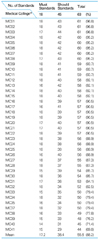Abstract
The present study investigates the performance and tasks of the accreditation performed by Korean Institute of Medical Education and Evaluation. The study analyzes survey data for 309 professors and 41 accreditation reports published during the first accreditation cycle (2000~2004). The finding shows that 32 medical colleges were accredited and 9 medical colleges were accredited on probation. Up to 98.5% of must standards' and 85.3% of 'should standards' were satisfied in this accreditation. The areas of accreditation standards, such as students, and facilities were satisfied relatively lower than the curriculum and administration/finances areas. However, 70.2% of the faculties replied that the accreditation achieved its purpose, and 80.7% of them pointed out the necessity of accreditation system. All these things make it clear that the accreditation system has made a significant contribution to the quality of medical education and the accountability of medical colleges. In addition, there are some issues which need more consideration, such as the government recognition of accreditation system, evaluation experts training, and practical application of accreditation results.
Figures and Tables
References
2. Bandaranayake RC. Assessment of quality of medical education through accreditation. Paper presented at the meeting of WHO/AMEWPR on quality assessment of medical education: Focus on medical licensure examinations. 1996. Seoul: AMEWPR;53–58.
3. Kassebaum DG, Cutler ER, Eaglen RH. On the importance and validity of medical accreditation standards. Acad Med. 1998. 73:550–564.

4. Simpson DE, Golden DL, Rehm JM, Kochar MS, Simons KB. The costs versus perceived benefit of an LCME institutional self-study. Acad Med. 1998. 73:1009–1012.
5. Hamilton JD. Establishing standards and measurement methods for medical education. Acad Med. 1995. 70:S. 51–56.

6. Chai JY. New establishment of medical school and medical education. Korean J Med Educ. 1998. 10:79–89.
7. Kim YI. Facilitating and impeding factors for promotion of educational planning in young medical schools. Korean J Med Educ. 2002. 14:227–243.

8. Yang EB. A study on the classification validity and predictive validity of accreditation standards for medical schools in Korea. Korean J Med Educ. 2002. 14:213–226.

9. Eaton JS. An overview of U.S. Accreditation. 2006. The Council for Higher Education Accreditation.




 PDF
PDF ePub
ePub Citation
Citation Print
Print





 XML Download
XML Download